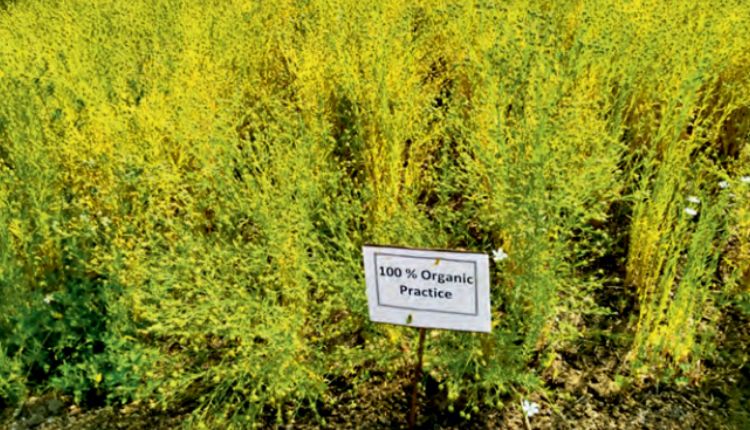Linseed Farming : Increase the yield with advanced techniques
India is the largest producer of linseed in area but ranks fourth in production. So, we need to increase the yield.
Linseed is a major oilseed crop of rabi season. Like all oilseeds, linseed is also a cash crop. Linseed oil obtained from its grains or seeds is of great commercial importance. In terms of area, India ranks first in the world in terms of linseed cultivation, because India’s share in the world’s land where linseed is cultivated is 15 percent.
India is the fourth largest producer of linseed in the world because Indian farmers do not adopt advanced cultivation techniques with full vigor. The major producing states of Linseed in the country are – Madhya Pradesh, Uttar Pradesh, Maharashtra, Bihar and Rajasthan. Linseed crop is mainly grown as a mixed crop with gram, barley and wheat. It is also grown along with sugarcane in autumn and along with many rabi crops, linseed crop is also grown on the edges of the field.

Widespread use of linseed oil
Linseed oil is also used in many aromatic oils and other medicinal products. Linseed oil also plays a major role in the manufacture of soaps, paints, varnishes and inks used in printing. It is also used as edible oil and lamp fuel. Flaxseed cake is also used as a fertilizer apart from an excellent animal feed.
Flaxseeds are ground and used along with other grains for consumption. Canvas, rugs and other thick clothes are prepared from the fibers obtained from the stem of its plants. After removing the fibers from the ripe linseed plants, a paper is made from the hard parts of its stem, which makes cigarettes.
Organic cultivation of linseed
Linseed can also be cultivated in semi-tropical, temperate and extreme climates. Organic farming of linseed can also be done. Linseed was grown under organic farming at the Indian Institute of Soil Science, Bhopal, affiliated to ICAR. As organic fertilizers, well decomposed cow dung manure, vermicompost and poultry manure were applied at the rate of 4 ton, 2.2 ton and 1.2 ton per hectare dry weight basis respectively. This increased the amount of nitrogen accumulated in the linseed field by 80 kg.
For plant protection, Trichoderma viridi was introduced into the soil to protect the crop from soil borne diseases and 0.03 per cent neem oil solution was sprayed. Pheromone traps were used for pest control. The results of organic farming showed that the yield per hectare of linseed decreased in the first three years but increased after that. If farmers produce organic linseed by using available organic fertilizers, then definitely in a few years the soil fertility will improve and higher yields and profits will be achieved.

Soil and preparation of linseed field
Black, heavy and loamy soil is suitable for linseed crop. But medium fertile and loamy soil is best for excellent production of linseed. In linseed crop, for good seed germination and plant growth, first plowing should be done in the field with soil turning plow and subsequent 3-4 plowing should be done by running country plow or harrow. After ploughing, it is necessary to put a bridge.
Improved varieties of linseed
15-20 kg seed per hectare is required for linseed cultivation. For large seeded varieties, the seed rate is 25-30 kg and for mixed cropping, the seed rate is 8-10 kg per hectare. Scientists of the Indian Council of Agricultural Research have recommended several improved varieties of linseed for different regions of the country. That’s why farmers should choose suitable seeds to earn well from linseed cultivation.
Improved Varieties of Linseed for Different Regions
| No. | State | Species |
| 1 | Uttar Pradesh | Sapphire, Heera, Mukta, Garima, Lakshmi 27, T-397, K-2, Shikha, Padmini |
| 2 | Punjab, Haryana | LC-54, LC-185, K-2, Himalini, Shweta, Shubhra |
| 3 | Rajasthan | T-397, Himalini, Chambal, Shweta, Shubhra, Gaurav |
| 4 | Madhya Pradesh | JLS(J)-1, Jawahar-17, Jawahar-552, Jawahar-7, Jawahar-18, Shweta, Shubhra, Gaurav, T-397, Mukta |
| 5 | Bihar | Bahar, T-397, Mukta, Shweta, Shubhra, Gaurav |
| 6 | Himachal | Himalini, K-2, LC-185 |
Linseed sowing season
The season from mid-October to mid-November is considered suitable for sowing of linseed. But if due to any reason sowing cannot be done during this time, then linseed can be sown till the end of November also. If sowing is to be done in the standing paddy crop in Bihar and Rajasthan, then by the end of September the seeds should be sown by broadcast method.
Sowing of linseed is done in different areas by broadcasting method and in rows. In Madhya Pradesh, broadcast sowing in a standing crop of paddy is called ‘Utera’ and in Bihar and Eastern Uttar Pradesh, ‘Pera’ method. For sowing in rows, sowing is done after preparing the manure at the desired distance. For sowing mixed crop, three rows of gram, followed by 5-8 rows of wheat, linseed crop is also sown in rows at a distance of one to one and a half meter. Two rows of linseed can be grown between two rows of sugarcane in autumn. Under normal conditions, the depth of seed sowing is kept at 3-4 cm.
Fertilizer for linseed farming
Determination of the quantity of nutrients should always be decided by getting the soil of that area tested. Normally, Nitrogen, Phosphorus and Potash should be given to linseed crop according to the quantity of 80, 40 and 20 kg per hectare respectively. More benefits are obtained by applying half the quantity of phosphorus and potash at the time of sowing and half the amount of nitrogen at the time of sowing and half at the time of first irrigation. Nitrogen application through ammonium sulphate improves the yield.

Irrigation and drainage for linseed farming
Cultivation of linseed in most areas of the country mainly depends on rain. Irrigation is very important in linseed cultivation. If there is no autumn rain, the first irrigation is beneficial when the plants develop 4-6 leaves and the second at the time of flowering.
Weeding and weed control
First weeding is done 30-35 days after sowing. At the same time, by sorting the plants in the rows, the distance between the plants is made 5-7 cm. Second weeding can be done after 20-25 days to make the crop free from weeds.
Harvesting, threshing and harvest
The grain crop is harvested from mid-March to early April. After harvesting the crop, the bundles are brought to the threshing floor. Here the bundles are dried for 4-5 days. Later on thresher separates the linseed seeds for threshing. Average yield of improved varieties of linseed is 15-25 quintals and mixed crop yields up to 4-5 quintals per hectare.

Storage
The grains should be dried to 10-12 percent moisture before keeping them in storage. High moisture content adversely affects the germination of seeds for the next sowing. The seeds can be stored for several days at 40°C temperature. This also does not affect germination badly.
Contact us: If farmers want to share information or experiences related to farming with us, then they can do this by calling us on the phone number 9599273766 or by writing an email to [email protected] or by sending your recording. Through Kisan of India, we will convey your message to the people, because we believe that if the farmers are advanced then the country is happy.



